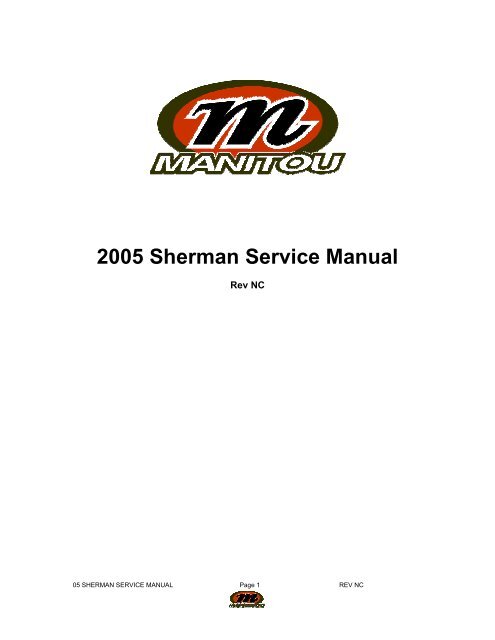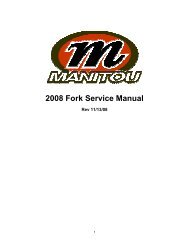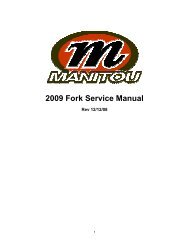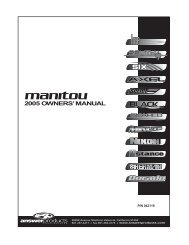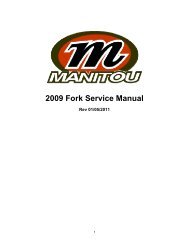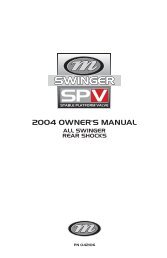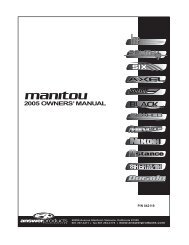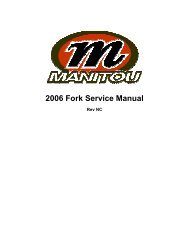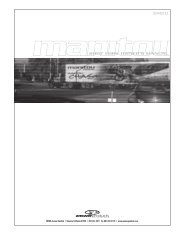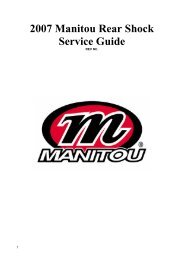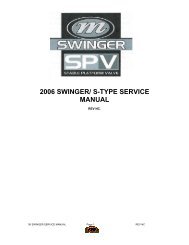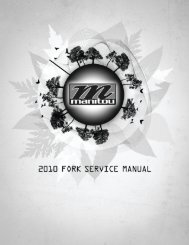2005 Sherman Service Manual - Manitou
2005 Sherman Service Manual - Manitou
2005 Sherman Service Manual - Manitou
Create successful ePaper yourself
Turn your PDF publications into a flip-book with our unique Google optimized e-Paper software.
<strong>2005</strong> <strong>Sherman</strong> <strong>Service</strong> <strong>Manual</strong><br />
Rev NC<br />
05 SHERMAN SERVICE MANUAL Page 1 REV NC
Table of Contents<br />
Description<br />
Page<br />
Introduction 3<br />
Front Suspension Terminology 4<br />
Disassembly Instructions 8<br />
Travel Adjust Systems: Rapid Travel II 11<br />
Assembly Instructions 14<br />
Bushing Removal and Installation Instructions 19<br />
Troubleshooting Chart 23<br />
<strong>Sherman</strong> Schematic and Technical Specifications 25<br />
<strong>Sherman</strong> Dual Crown Schematic and Technical Specifications 26<br />
<strong>Sherman</strong> <strong>Service</strong> Kit Chart 27<br />
Contact Information<br />
Answer Products Customer <strong>Service</strong> Department<br />
28209 Ave. Stanford<br />
Valencia, CA 91355<br />
Toll Free: (800) 423-0273<br />
Direct: (661) 257-4411<br />
FAX: (661) 775-1798<br />
E-mail: warranty@answerproducts.com<br />
tech@answerproducts.com<br />
Web site: www.answerproducts.com<br />
05 SHERMAN SERVICE MANUAL Page 2 REV NC
INTRODUCTION<br />
This manual is intended to guide the user through basic service of <strong>Manitou</strong> <strong>Sherman</strong> front forks.<br />
<strong>Service</strong> is supported by the identification of common parts and assemblies that have been<br />
assembled into <strong>Service</strong> Kits. The purpose of this manual will be to describe conditions that may<br />
drive the need for service and to provide installation instructions for the kits.<br />
Due to the time-consuming nature of suspension fork service, at this time our primary focus is to<br />
offer service kits that minimize the amount of downtime and labor involved.<br />
Important information is highlighted in this manual by the following notations:<br />
WARNING<br />
Failure to follow WARNING instructions could result in severe injury or death to the<br />
person inspecting or repairing the suspension fork or the user.<br />
CAUTION<br />
A CAUTION a caution indicates special precautions that must be taken to avoid damage to<br />
the product.<br />
NOTE<br />
A NOTE provides key information to make procedures easier or clearer<br />
GENERAL WARNING: Suspension forks by design contain gases and fluids under extreme<br />
pressure and warnings contained in this manual must be observed to reduce the<br />
possibility of injury or possible death. Following these instructions can help you reduce<br />
the risk of being injured. Any questions in regards to the information in this manual<br />
should be directed to Answer Products Customer <strong>Service</strong> at (661) 257-4411.<br />
WARNING: The <strong>Sherman</strong> uses compressed air to provide fluid pressure in the damping<br />
system in some models. This system must be relieved of pressure prior to servicing these<br />
systems. Failure to relieve air pressure could result in injury or possible death.<br />
CAUTION: The <strong>Sherman</strong> suspension fork uses precision machined aluminum and other soft alloy<br />
components. Using correct tools for assembly is essential to prevent damage.<br />
05 SHERMAN SERVICE MANUAL Page 3 REV NC
FRONT SUSPENSION TERMINOLOGY<br />
Air Cap – Top cap that threads into top of air/spring leg (this is the left leg of the fork as you are<br />
seated on the seat). Forks may be controlled with an air/spring or a coil spring. The air cap<br />
contains the Schrader Valve, which is used to control the spring rate or SAG of air forks.<br />
Air Spring – A mechanism that is used to control the SAG of an air fork.<br />
Arch – A support that connects the two outer lower legs of the casting so as to keep them moving<br />
in unison.<br />
Black Nitrate Leg Coating – New coating for steel stanchion legs that reduces stiction.<br />
Boss – The word used to describe an outer casting that has brake posts for V-brakes or<br />
cantilever brakes.<br />
Bottom Out Bumper – A rubber or elastomer device that absorbs the shock that occurs when a<br />
suspension is compression to its limit.<br />
Bushings – A cylindrical sleeve between a fork stanchion tube (inner leg) and a fork outer<br />
casting (slider), which facilitates the sliding movement between these two parts.<br />
Coil Spring Air Assist – A new feature for <strong>2005</strong> that utilizes a full length coil spring and allows<br />
you to increase the spring rate of the fork by adding air as a booster to that coil spring.<br />
Coil Spring – A coiled piece of metal that acts as a spring to help suspend a fork.<br />
Compression – The phase of the suspension operation in which the wheel travels up, or travels<br />
closer to the frame. The suspension forks reaction to a bump in the trail.<br />
Compression Damping – Restriction of the rate that the suspension compresses under load.<br />
Convertible Travel – A system used to alter the travel of a suspension fork. It requires moving a<br />
travel clip on the compression rod to a different position. This operation is accomplished by<br />
disassembling the fork and physically moving the travel clip on the compression rod.<br />
Crown Steerer Assembly – the stanchion legs (inner legs), the fork crown, and the steer tube<br />
pressed together as one assembly. This assembly is then finished by adding all of the fork<br />
internals and then outer casting (slider).<br />
Damping – A function that modifies the rate of suspension compression or rebound.<br />
Detent – An indentation that causes a rotating adjuster to stop at fixed increments.<br />
Drop Out – The end of an outer casting (slider) where the wheel attaches.<br />
Dust Boot – Usually a piece of rubber in the shape of a cylinder with baffles to allow it to<br />
compress as the fork compresses through its travel. Its function is to help keep dirt and water<br />
from getting into the inner legs of the fork.<br />
FFD – Fluid Flow Damping. A <strong>Manitou</strong> patented low cost oil damping system. The compression<br />
damping is non-adjustable and the rebound damping may be non-adjustable or adjustable<br />
damping.<br />
Fork Crown – The component that joins the stanchion tubes (inner legs) to the steer tube of the<br />
fork.<br />
05 SHERMAN SERVICE MANUAL Page 4 REV NC
FRONT SUSPENSION TERMINOLOGY (CONT.)<br />
Hydraulic Fork Oil – Oil used in suspension designs to provide damping. It has special<br />
characteristics that determine how it reacts when exposed to compressed air, how it changes<br />
viscosity when its temperature changes, and how it moves through valves.<br />
Hydraulic Lock Out – a condition caused when the mixture of air and damping oil is out of<br />
balance. It is caused when there is too little air space in a chamber, not allowing the fork to<br />
compress through its travel.<br />
Infinite Travel System (IT) – A handle-bar mounted air travel adjust system that allows the rider<br />
to change the fork travel (and ride height) without a spring rate change. The travel can be<br />
changed from full compression to full rebound and at any place in between.<br />
Lock Out – a special function that restricts the compression of the fork from moving. It is<br />
generally controlled by an external knob that is activated when a rider does not want the fork to<br />
move, thus eliminating extra energy needed to overcome the bobbing forces of the fork.<br />
MCU – (Micro-Cellular Urethane) Special urethane that is filled with tiny air cells that act like<br />
springs when the elastomer is compressed.<br />
Micro Lube – Lubrication system that is operated by injecting small quantities of grease directly<br />
into ports that are inserted into outer casting legs. This enables the lubrication of the fork without<br />
having to disassemble it.<br />
No Boss - The word used to describe an outer casting that has no brake posts for V-brakes or<br />
cantilever brakes. This casting is to be used for disk brakes only.<br />
Oil Damping – A system that uses the resistance to oil flow through holes in a valve to provide a<br />
means to alter the rate of suspension compression or rebound.<br />
Oil Level – The level of damping oil needed for the optimal damping performance of a<br />
suspension. It is measured as the air space distance between the top of the stanchion leg (inner<br />
leg) and the height of the oil inside of the leg. The fork must be completely extended in order to<br />
get an accurate measurement.<br />
O-Ring – A soft, flexible neoprene or Buna rubber ring with a round cross-section, which is used<br />
for sealing and retention.<br />
Oil Weight – A description of the relative viscosity of oil, such as hydraulic oil. Oil with low weight<br />
numbers (5wt or 7wt) flows through the valving with less resistance than higher weight numbers<br />
(10or 15 wt).<br />
One Point Five Standard - 1.5 inch interface standard for frame head tubes, headset, cups,<br />
stem, and steer tubes which allows for the lightest weight and strongest design in 170mm single<br />
crown forks. This design greatly improves the control and steering precision of the fork. It is used<br />
predominately on forks with longer travel and the intended use is for more hardcore, extreme<br />
riding.<br />
Outer Casting – (see Slider)<br />
Preload – A condition of compressing a spring or elastomer before the operating loads are put on<br />
the suspension, so that it provides a stiffer spring rate.<br />
05 SHERMAN SERVICE MANUAL Page 5 REV NC
FRONT SUSPENSION TERMINOLOGY (CONT.)<br />
Piston – In front suspension, the part of the damper that slides back and forth inside of the<br />
damping leg that houses the valves. It can also refer to the air piston in the air/spring assembly<br />
that slides back and forth compressing the air, thus causing a change in the spring rate of the<br />
suspension.<br />
Porosity – The condition or property of having pores in a material that will allow gas or liquid to<br />
pass through it.<br />
Platform Plus Damping – A new damping system found on <strong>2005</strong> Rear shocks (featured on<br />
Metel and Radium’s). This system will establish a pedaling efficiency platform similar to SPV, but<br />
is done through unique valving that is not adjustable (helps in bump control).<br />
Rapid Travel II, Wind Down – Systems that are used to control the travel of suspension forks.<br />
Also known as RTII, and WD. RTII is used for the specific purposes of controlling the travel in two<br />
conditions: climbing and descending. WD is an incremental travel adjustment between to set<br />
limits and does not affect the spring rate of the fork as severely as RTII.<br />
Quad Ring seal – New seal that replaces standard o-rings in designs that require more efficient<br />
air and oil sealing methods.<br />
Rebound – The phase of the suspension operation in which the wheel returns to its original<br />
position on the ground after compression.<br />
Rebound Damping – Restriction of the rate that the suspension rebounds when the compression<br />
load is relived.<br />
Remote Lock out system – A handle-bar lever actuated system that controls the lock out<br />
function on front and rear suspension products.<br />
Reverse Arch Technology – Also known as RA. It is a system that is designed to move the arch<br />
of a fork to the backside of a fork, rather than the conventional front position. It was designed to<br />
provide greater rotational torque strength to an outer casting (slider), without adding additional<br />
weight to the fork.<br />
Sag – The amount a suspension fork compresses at rest with a normal load (rider’s weight).<br />
Schrader Valve – Valve used to introduce air into a chamber.<br />
Seal – A part, usually neoprene rubber or Buna, that keeps contaminants out and/or working<br />
fluids in.<br />
Semi Bath – A lubrication system that uses a lubricating oil to keep the bushing surface and<br />
stanchion legs (inner legs) as friction free as possible during movement of the stanchion legs.<br />
Spring Rate – The rate at which the resistance of a spring increases as it is compressed.<br />
SPV – (Stable Platform Valve) new damping system that allows the rider to set the pedaling<br />
platform that he desires to pedal most efficiently in all situations. It is dependent on the pressure<br />
that the SPV valve experiences from the movement of the wheel vs. the terrain and the platform<br />
that is set by pressure introduced to other side of the SPV valve through changes of air pressure<br />
working on the damping oil.<br />
SPV Evolve – The latest version of SPV damping technology that has increased its performance<br />
with modifications to the original design.<br />
05 SHERMAN SERVICE MANUAL Page 6 REV NC
FRONT SUSPENSION TERMINOLOGY (CONT.)<br />
Slider/Outer Casting – The tube (outer casting leg) of the suspension fork that0. remains fixed to<br />
the wheel. It slides up and down on the stanchion leg (inner leg).<br />
Stanchion Clamps - (Double-Triple Clamps) the portions of the fork crown that clamp around the<br />
stanchion legs above and below the head tube of the bicycle frame on specific long travel<br />
applications.<br />
Stanchion Legs – The suspension tube (inner leg) fixed to the fork crown. It remains stationary<br />
during the operation of the suspension.<br />
Steer Tube – The long cylindrical tube that extends from the top of the fork crown. Its function is<br />
to be inserted into the bicycle head tube and attach the suspension to the bicycle frame.<br />
Thru Axle – (Hex-lock) A device used for mounting a thru axle hub to special outer legs that are<br />
not made for standard quick release hubs. <strong>Manitou</strong>’s Hex-lock (thru axle) system is a special<br />
patented system utilizing a hex shaped end that increases the stiffness of the fork and reduces<br />
slippage in the joint between the axle clamps and the axle.<br />
Top Out Bumper – A rubber, coil spring, or elastomer device that absorbs the shock that occurs<br />
when the load is taken off a suspension so that it is allowed to rebound to its limits<br />
TPC – (Twin Piston Chamber) a patented damping system that has independent pistons for<br />
rebound and compression. The system utilizes a mixture of air and oil in the damping leg of the<br />
fork to enhance the damping performance.<br />
TPC+ - A variation of TPC that has added a floating piston to the compression damper to<br />
enhance the performance of the compression damping under the load of bigger hits.<br />
Travel – The amount that a wheel moves between the most compressed and the most extended<br />
states of the suspension<br />
Viscosity – A description of how a liquid flows. Liquids with higher viscosity are thicker flow less<br />
easily or quickly than liquids with low viscosity. This has an affect on the damping speeds of<br />
rebound and compression.<br />
Volume Control – A new system designed to work with SPV as a control of the compression<br />
ramp up rate of the fork. It has a range of adjustments from linear to very progressive.<br />
Wiper Seal – A rubber material that is used as a seal to keep dirt and water out of the outer<br />
casting legs. It is not designed to keep air pressure or extreme oil pressure in. <strong>Manitou</strong> has the<br />
new Evil Genius wiper seals.<br />
05 SHERMAN SERVICE MANUAL Page 7 REV NC
<strong>2005</strong> <strong>Sherman</strong> Forks Disassembly and Rebuild Instructions<br />
Removal of Outer Casting<br />
Disassembly Instructions<br />
WARNING This fork uses a preloaded coil spring provide spring resistance. The spring<br />
must be relieved of its preload prior to servicing. Failure to do so could result in injury or<br />
possible death.<br />
1. On forks with Rapid Travel Adjust II (Top Travel Adjust), be sure to set travel to its<br />
longest setting. Rotate knob on top left of fork leg clockwise towards the front of the fork<br />
and then push down on the fork to release its travel into the longest mode. More<br />
complete instructions for servicing Travel Adjust systems may be found in the “Travel<br />
Adjust “section.<br />
2. Turn the fork upside down and remove the fixing screw that attaches the Rebound<br />
Adjuster Knob (Blue). Set the knob and screw aside.<br />
USE: 2mm Allen wrench to unscrew fixing screw.<br />
3. Remove the 11mm Compression Rod bolt from the bottom of the left leg (From the rider's<br />
perspective).<br />
USE: 11mm socket, nut driver, or open-end wrench.<br />
4. Insert 8mm Allen wrench into the end of the Rebound Damper Shaft on the bottom of the<br />
right leg. Turn the wrench in a Clock Wise direction in order to loosen the damper shaft<br />
in the casting (See Figure below). You are turning the Damper Shaft in a way that causes<br />
it to disappear into the casting leg.<br />
USE: 8mm Allen wrench<br />
5. Working with the “Semi Bath” lubrication system:<br />
A. Position the bottom of the fork legs over a drain pan that is on the ground. Pull the<br />
casting downward towards the pan, allowing the Semi Bath oil in the casting to drip<br />
into the pan. Pull the casting completely off of the inner legs and wipe any excess oil<br />
off of inner legs and inside of casting.<br />
USE: Drainage pan and extra rags<br />
05 SHERMAN SERVICE MANUAL Page 8 REV NC
Removal of TPC+ Compression Damping Assembly<br />
1. Be sure to twist adjuster knob all the way clockwise to decrease damping effect on fork.<br />
Then, unscrew 2mm Allen screw from top of TPC+ adjuster knob (knob on top left<br />
stanchion leg).<br />
2. Remove adjuster knob and unscrew remaining assembly from stanchion leg with a<br />
20mm socket.<br />
3. Pull assembly from leg in a twisting motion and be aware that oil that is on top of the<br />
TPC pistons will come out with the assembly. Have a rag handy.<br />
Removal of SPV Compression Damping Assembly<br />
WARNING This fork uses compressed air as part of the SPV damping system and must be<br />
relieved of pressure prior to servicing. Failure to relieve air pressure could result in injury<br />
or possible death.<br />
1. Remove Schrader valve dust cap from Red Hex Shaped Top Cap on the top right of the<br />
crown. Release all air pressure from the Schrader valve.<br />
2. Remove SPV Volume Control Cap (Red Hex Shaped Top Cap) from top right of the crown<br />
with a 24mm Socket. Turn fork upside down over drainage pan to empty Damping oil from<br />
the inner leg. Stroke the Damper shaft on the bottom of the inner leg 3-5 times to purge the<br />
leg of oil that is caught below the oil piston.<br />
USE: 24mm Socket, Valve core removal tool or small object that<br />
can be used to depress valve stem.<br />
Removal of TPC and SPV Rebound Damping Assembly<br />
1. Unscrew Damper end cap from the bottom of the right leg and then pull the TPC or SPV<br />
damping assembly out of inner leg. Be aware that a small amount of damping oil will<br />
come out with the assembly. This oil is the oil that is trapped under the piston.<br />
05 SHERMAN SERVICE MANUAL Page 9 REV NC
2. Checking the function of the SPV valve:<br />
a. Visually inspect the gap between the SPV valve and the bottom of the damping<br />
piston. It should have approximately 1mm of space. The valve should also spring<br />
back to its open rested position after compressing it with your fingers.<br />
*If the valve is not responsive or all the time closed, it is bad and the assembly<br />
needs to be replaced.<br />
USE: 24mm Open-end wrench or 8-10” Adjustable wrench<br />
Check for 1mm gap<br />
between the blue<br />
SPV valve and the<br />
black piston<br />
Removal of Spring and Compression Rod Assembly<br />
WARNING This fork uses a preloaded coil spring provide spring resistance. The spring<br />
must be relieved of its preload prior to servicing. Failure to do so could result in injury or<br />
possible death.<br />
1. For <strong>Sherman</strong> Single Crown forks (Rapid Travel II): Remove the adjuster knob from the top<br />
of the travel adjust assembly on the top of the crown on the left side of the fork, by<br />
unscrewing the 2mm Allen head screw. Use a 20mm socket and unscrew the remainder of<br />
the assembly from the crown. The spring will be attached to the bottom of the assembly,<br />
when you pull it from the inner leg.<br />
2. Pull the spring from the assembly and it can be substituted with a different rated spring if<br />
necessary.<br />
05 SHERMAN SERVICE MANUAL Page 10 REV NC
3. The compression rod assembly may be removed by unscrewing the end cap on the bottom of<br />
the left leg. After unscrewing the end cap, pull the assembly from the inner leg.<br />
4. For more specific details on Rapid Travel II, refer to “Travel Adjust” section of this<br />
manual.<br />
5. For <strong>Sherman</strong> Dual Crown forks: Remove the top cap from the top of the crown on the left<br />
side of the fork with a 20mm socket. The spring will be attached to the bottom of the<br />
assembly, when you pull it from the inner leg.<br />
6. Pull the spring from the assembly and it can be substituted with a different rated spring if<br />
necessary.<br />
7. The compression rod assembly may be removed by unscrewing the end cap on the bottom of<br />
the left leg. After unscrewing the end cap, pull the assembly from the inner leg.<br />
USE:<br />
24mm Open-end wrench or 8-10” Adjustable wrench,<br />
2mm Allen wrench, 20mm socket<br />
(Note: If you are going to change the spring without taking the entire fork apart, you<br />
must first unscrew the compression rod on the bottom of the left fork leg. Now you<br />
may unscrew the top cap and remove it and the spring. It may be necessary to exert<br />
extra force when pulling the spring out of the leg.)<br />
Bushing Removal & Installation<br />
Please refer to section on Bushing Removal & Installation.<br />
Rapid Travel II <strong>Service</strong> Instructions<br />
Disassembly:<br />
WARNING This fork uses a preloaded coil spring provide spring resistance. The spring<br />
must be relieved of its preload prior to servicing. Failure to do so could result in injury or<br />
possible death.<br />
1. Make sure that fork is in long travel mode by turning T/A knob clockwise until it stops,<br />
then compress fork one time and release it into long travel.<br />
2. Unscrew 2mm Allen Head from top of knob.<br />
3. Unscrew top cap that is threaded into crown with 20mm socket.<br />
4. Remove spring from inner leg.<br />
5. From the right leg dropout, use a 2mm Allen wrench to remove rebound damper adjuster<br />
knob. Use an 8mm Allen wrench and turn the damper shaft clockwise until it can be<br />
pushed into the casting.<br />
6. Remove Compression Rod bolt from the left leg dropout with a 7/16” socket or open end<br />
wrench.<br />
7. Remove crown/steer/inner leg assembly from the outer leg casting. Be sure to drain all<br />
Semi Bath oil out of casting before re-assembly of fork.<br />
8. Remove left leg end cap and compression rod assembly from inner leg.<br />
05 SHERMAN SERVICE MANUAL Page 11 REV NC
Assembly:<br />
(See Photos on Next page)<br />
WARNING When installing the outer Leg Casting to the Crown Steer Assembly, Drop Out<br />
bolts and Damper Shafts must be properly tightened prior to use. Failure to do so could<br />
result in injury or possible death.<br />
1. Install travel adjust compression rod assembly into inner left leg and torque end cap to<br />
20inlbs. Be sure to put a dab of Blue Loctite on the end cap threads before<br />
installing cap into leg.<br />
2. Grease spring and insert into inner leg. If spring does not go in all of the way, twist it<br />
slightly and it will fall into place. Do not force spring into leg.<br />
3. Install top cap with 20mm socket and do not tighten it all of the way. Be sure to put a<br />
dab of Blue Loctite on the end cap threads before installing cap into leg.<br />
4. Install rebound assembly, start threads by hand and then torque to 20inlbs. Be sure to<br />
put a dab of Blue Loctite on the end cap threads before installing cap into leg.<br />
5. Pull out damper shaft as far as it will go.<br />
6. Press inner legs into casting about half way and then inject Semi Bath oil (5/20wt.<br />
synthetic oil) into outer casting, holding fork at 45 degree angle to the ground with bottom<br />
of fork in the air (drop outs up). Inject 16 cc’s of oil into each outer leg. It is<br />
recommended to use a syringe to inject oil.<br />
7. Press inner leg assembly into outer leg casting until damper shaft contacts casting.<br />
8. Use an 8mm hex wrench to turn the damper shaft counterclockwise, threading it into the<br />
casting. Torque to 20inlbs.<br />
9. Install rebound adjuster knob.<br />
10. Press inner leg assembly into outer leg casting until compression rod contacts casting.<br />
11. Install Compression rod screw, torque to 40-50inlbs.<br />
12. Set travel adjust knob all the way clockwise, compress fork, and then release to verify<br />
that it is in longest travel.<br />
13. Remove adjuster knob, then remove top cap with 20mm socket. Twist aluminum hex<br />
shaped shaft clockwise until you meet resistance, release shaft and let it return naturally<br />
to wherever it stops.<br />
14. Using a marking pen, mark one side of the hex shaped shaft that is facing the front of the<br />
fork. Remember where that colored side is in relation to the crown of the fork. Install top<br />
cap and tighten to 35-50inlbs.<br />
WARNING All top caps for Damper and Spring systems must be properly tightened prior to<br />
use. Failure to do so could result in injury or possible death.<br />
15. Twist hex shaped shaft counterclockwise until it is in the same position that it was in<br />
before you installed top cap. Install adjuster knob so that tang of knob is all the way<br />
clockwise and then tighten 2mm Allen screw until tight.<br />
16. Compress fork and it should be in long travel and plush. Twist knob all the way in the<br />
other direction (towards the arch of the fork) and compress fork. You should hear the<br />
Travel adjust mechanism engage and the travel will now be shorter.<br />
05 SHERMAN SERVICE MANUAL Page 12 REV NC
Top Travel Adjust Components<br />
Compression<br />
Rod Bolt<br />
Travel Adjust/Compression Rod<br />
Assembly<br />
Plastic Spring<br />
Foot<br />
Spring &<br />
Spool<br />
Top cap &<br />
Adjuster knob<br />
Removal & Installation of<br />
Adjuster Knob<br />
Removal & Installation<br />
of top cap<br />
05 SHERMAN SERVICE MANUAL Page 13 REV NC
Twisting Hex<br />
Shaft in order<br />
to clock<br />
assembly<br />
Assembly of Crown Steer/Leg Assembly<br />
<strong>Sherman</strong> Single Crown forks<br />
(Note: Apply a small dab of Blue Loctite on all top cap and leg end cap threads before<br />
reinstalling them in fork.)<br />
1. Make note of which is the right leg of the crown/steer/leg assembly (fork serial # is etched<br />
into the back of the right crown of the fork, from the rider’s perspective) and which leg<br />
is the left one. Turn the assembly upside down, so that the bottoms of the inner legs are<br />
facing you. In the left leg; insert the Travel adjust compression rod assembly, and tighten end<br />
cap into leg. Tighten to torque values that are listed on fork schematic.<br />
WARNING All leg caps for Damper and Spring systems must be properly tightened prior to<br />
use. Failure to do so could result in injury or possible death.<br />
2. Now, install SPV rebound damping assembly or TPC rebound damping assembly into bottom<br />
of other inner leg. Be sure to check the function of the SPV valve and apply a thin layer of<br />
Prep M grease onto o-ring that is around the piston at top of assembly. Install the assembly<br />
and tighten end cap to specified torque value.<br />
Check for 1mm gap between Blue SPV valve<br />
and Black piston. If there is no gap, assembly<br />
needs to be replaced.<br />
05 SHERMAN SERVICE MANUAL Page 14 REV NC
3. Turn Crown/steer/leg assembly right side up, so that the crown of the assembly is facing you.<br />
Extend the SPV rebound damping assembly or TPC rebound damping assembly all the way<br />
out and then pour damping oil (P/N: 85-0023) into the right inner leg. Fill leg about ¼ of the<br />
way up. Take a rag and cover the top of the right inner leg and then stroke the SPV damping<br />
assembly up and down about 5 times. This will insure that oil gets below the piston and not<br />
create an air space. Extend the damping assembly all the way out and then fill the inner leg<br />
to the specified oil level.<br />
WARNING All top caps for Damper and Spring systems must be properly tightened prior to<br />
use. Failure to do so could result in injury or possible death.<br />
4. Insert the Volume control assembly or TPC+ compression damping assembly into the top of<br />
the right inner leg and tighten it to specified torque value. Be sure that you unscrew the red<br />
16mm Hex shaped Volume control nut all of the way counterclockwise after you tighten the<br />
entire assembly into the inner leg.<br />
5. Insert spring into the top of the left leg and follow procedure in “Rapid Travel II” service<br />
instructions for clocking the travel adjust.<br />
Use: 8-10” adjustable wrench, <strong>Manitou</strong> Volume Control Adjuster (P/N: 85-3007),<br />
24mm socket, metric ruler<br />
<strong>Sherman</strong> Dual Crown forks<br />
Clamp Fixing<br />
Bolts<br />
1. Removal of inner legs from Dual Clamps:<br />
Loosen upper clamp fixing bolts with a 4mm Allen wrench and remove upper clamp from<br />
inner legs.<br />
Loosen lower clamp fixing bolts with a 4mm Allen wrench and remove lower clamp from<br />
inner legs. You may have to remove the frame bumpers first to remove the lower clamp.<br />
2. Installation of inner legs into Dual Clamps:<br />
WARNING All Triple Clamp Pinch Bolts must be properly tightened prior to use. Failure to<br />
do so could result in injury or possible death.<br />
Insert inner legs into lower clamp about 5 inches (125mm).<br />
Install upper clamp onto the inner legs and steer tube, so that the top of the upper clamp<br />
is flush with the top of the inner legs. Do not tighten fixing bolts at this time, because you<br />
will have to make adjustments to the distance between the clamps before you install the<br />
fork on your bike.<br />
3. Install SPV rebound damping assembly or TPC rebound damping assembly into bottom<br />
of right inner leg. Be sure to check the function of the SPV valve and apply a thin layer<br />
of Prep M grease onto o-ring that is around the piston at top of assembly. Install the<br />
assembly and tighten end cap to specified torque value. Be sure to put a dab of Blue<br />
Loctite on the end cap threads before installing cap into leg.<br />
WARNING All leg caps for Damper and Spring systems must be properly tightened<br />
prior to use. Failure to do so could result in injury or possible death.<br />
05 SHERMAN SERVICE MANUAL Page 15 REV NC
4. Install compression rod assembly into bottom of left inner leg and tighten to specified<br />
torque value. Be sure to put a dab of Blue Loctite on the end cap threads before<br />
installing cap into leg.<br />
5. Turn Crown/steer/leg assembly right side up, so that the crown of the assembly is<br />
facing you. Extend the SPV rebound damping assembly or TPC rebound damping<br />
assembly all the way out and then pour damping oil (P/N: 85-0023) into the right inner<br />
leg. Fill leg about ¼ of the way up. Take a rag and cover the top of the right inner leg<br />
and then stroke the SPV damping assembly up and down about 5 times. This will<br />
insure that oil gets below the piston and not create an air space. Extend the damping<br />
assembly all the way out and then fill the inner leg to the specified oil level.<br />
6. Insert the Volume control assembly or TPC+ compression damping assembly into the<br />
top of the right inner leg and tighten it to specified torque value. Be sure that you<br />
unscrew the red 16mm Hex shaped Volume control nut all of the way counterclockwise<br />
after you tighten the entire assembly into the inner leg.<br />
WARNING All top caps for Damper and Spring systems must be properly tightened prior to<br />
use. Failure to do so could result in injury or possible death.<br />
7. Insert spring into top of left leg followed by top cap. Tighten top cap to specified torque<br />
value.<br />
Setting Dual Crown Fork Ride Height<br />
1. When setting the ride height for your fork, make this calculation to determine the lowest<br />
point at which you can set the lower clamp without it interfering the casting’s arch on full<br />
compression: Travel of fork + 20mm.<br />
This is the<br />
distance that<br />
you are<br />
calculating<br />
2. The number that you calculate will be measured from the top of the dust seal on the<br />
casting to the bottom of the lower clamp.<br />
Warning: Do not set the lower crown lower than the measurement that you<br />
calculated for fear of interference with brake arch.<br />
Installation of Hex Thru Axle<br />
1. Hold wheel between drop outs. Insert Hex Thru Axle into the outside of the left<br />
Drop out (as you are facing fork) and push it through the hub of the wheel into the right<br />
drop out.<br />
2. Thread Thru Axle nut into the end of the axle that is in the right drop out. Thread in half<br />
Way.<br />
3. Set the end of the axle flush with the outside of the left drop out and tighten the 3mm<br />
clamp fixing bolts to specified torque value as called out in “Slider/Slider + Fastener<br />
05 SHERMAN SERVICE MANUAL Page 16 REV NC
Torque and Set up Values” at end of manual.<br />
4. Finish the installation by tightening axle nut to specified torque value and then tighten<br />
the clamp fixing bolts on the right drop out to the specified torque.<br />
(see photo below)<br />
Axle Nut<br />
Left Drop out<br />
Right Drop out<br />
Installation of Outer Casting<br />
WARNING When installing the outer Leg Casting to the Crown Steer Assembly, Drop Out<br />
bolts and Damper Shafts must be properly tightened prior to use. Failure to do so could<br />
result in injury or possible death.<br />
1. Turn completed crown/steer/leg assembly upside down, so that the compression rod and<br />
SPV damper shaft are facing you. You will see a bottom out bumper on the SPV or TPC<br />
damper shaft; slide this bumper down towards the end cap that is threaded into the inner leg.<br />
This will help in keeping the shaft extended as you install the outer casting. On SPV equipped<br />
forks, you could also insert air into the damper leg through the Schrader valve on top of the<br />
right leg. This extra pressure will help to keep the shaft from moving.<br />
2. Press inner legs into casting about half way and then inject Semi Bath oil (5/40wt. synthetic<br />
oil, P/N: 85-0022) into outer casting, holding fork at 45 degree angle to the ground with<br />
bottom of fork in the air (drop outs up). Inject 16cc’s of oil into each outer leg. It is<br />
recommended to use a syringe to inject oil (Figure 1).<br />
3. Press inner leg assembly into outer leg casting until damper shaft contacts casting. (It is<br />
recommended to extend rebound damper out from end cap as far as it will go and then slide<br />
bottom out bumper towards the end cap as far as it will go. The bumper will help to hold the<br />
damper shaft in place as you are inserting the inner legs into the casting). Use an 8mm hex<br />
wrench to turn the damper shaft counterclockwise, threading it into the casting. Tighten to<br />
specified torque values.<br />
4. Install rebound adjuster knob. Knob should turn uninhibited until the indicator is stopped by<br />
the casting. If not, remove knob and reinstall on hex shaft in 1/6 turn increments until full<br />
travel is reached.<br />
5. Install the compression rod screw and tighten to specified torque values.<br />
Use: 8mm Allen wrench, 2mm Allen wrench, 11mm nut driver or<br />
open end wrench, syringe for Semi Bath oil.<br />
05 SHERMAN SERVICE MANUAL Page 17 REV NC
Figure 1<br />
Adding Semi Bath oil to a casting<br />
with Syringe<br />
05 SHERMAN SERVICE MANUAL Page 18 REV NC
Bushing Removal & Installation<br />
Bushing Removal<br />
(Note: use appropriate removal ring that corresponds to the leg diameter of the fork being<br />
repaired)<br />
Leg Diameter Answer Kit #<br />
25.4mm (1”) 85-5191<br />
28.6mm (11/8”) 85-5189<br />
30mm 85-5194<br />
32mm 85-5192<br />
Bushing Removal Tool Components<br />
A. Slide Hammer<br />
B. Threaded Handle<br />
C. Slide<br />
D. Threaded Shaft<br />
E. Removal Ring<br />
Bushing Removal Tool Assembly<br />
05 SHERMAN SERVICE MANUAL Page 19 REV NC
Bushing Removal (CONT.)<br />
Bushing Removal Instructions<br />
A. Install 25.4mm Removal ring on the<br />
shiny, smaller diameter threaded shaft.<br />
Be sure to install the ring with the<br />
tapered, chamfered end first, followed by<br />
the long slide tube. This tapered end<br />
leads the tool through the bushing.<br />
B. Start the procedure by removing the<br />
Dust/Wiper seal with a screwdriver,<br />
prying it out.<br />
C. Insert Removal tool past the upper<br />
bushing and then stop. It is important to<br />
pull one bushing out at a time. Push the<br />
slide on the threaded shaft down<br />
towards the removal ring. Hold the<br />
casting with one hand and the slide<br />
hammer with your other hand. Now<br />
move the slide hammer in a motion away<br />
from the casting and repeat this action<br />
until the bushing comes out.<br />
D. For all other leg diameters: use the<br />
larger diameter (dark colored) threaded<br />
shaft and repeat steps A-C.<br />
Bushing Installation<br />
(Note: Sizer kits listed in above chart contain the sizers needed for each specific leg diameter.)<br />
Bushing Installation Tool Components<br />
1. Installation Mandrel<br />
2. Threaded Rod w/nuts<br />
3. Sizer rings<br />
4. Spacer<br />
5. Washer<br />
6. Nut<br />
(1) (2)<br />
(3) (4) (3) (5) (6)<br />
05 SHERMAN SERVICE MANUAL Page 20 REV NC
Bushing Installation (CONT.)<br />
Bushing Installation Tool Assembly<br />
With weighted handle<br />
When selecting sizer rings to install bushings,<br />
choose the two rings that are in the middle of<br />
the size run to start with.<br />
1. Assemble installation tool as shown in<br />
picture above. Each leg diameter kit has all<br />
of the needed pieces to remove and install<br />
bushings for forks with serviceable<br />
bushings. Some of the kits come with<br />
gauges to tell you how far to drive in the<br />
lower bushings. Upper bushings are driven<br />
in as far as the stop in the top of the<br />
casting will allow. The general rule of<br />
thumb is that the lower bushings must not<br />
be driven any deeper than 5” into a casting<br />
leg. If they do go deeper, call Customer<br />
<strong>Service</strong> at Answer Products – 800-423-<br />
0273 for a new outer casting.<br />
2. Always assemble Mandrel with the larger<br />
diameter sizer ring being placed on the<br />
mandrel first, then the spacer, the next<br />
largest sizer ring, followed by the washer<br />
and the nut to hold it in place. Be sure to<br />
lock the nut above the Mandrel and below<br />
the Mandrel against each other.<br />
3. Replace the lower bushing (bushing with a<br />
thicker wall diameter) first. Place a small<br />
amount of Prep M grease onto the sizer<br />
rings to help the rings come through the<br />
bushings when pulling them out. Slide<br />
bushing onto Mandrel until it stops. Apply<br />
a bead of Red Loctite all the way around<br />
the outside of the bushing. Hold casting on<br />
top of bench with a rag under the end of<br />
the legs and insert installation tool with<br />
bushing into casting leg.<br />
05 SHERMAN SERVICE MANUAL Page 21 REV NC
Bushing Installation (CONT.)<br />
4. Slide weighted handle onto end of threaded rod and tap rod into casting with rubber Mallet<br />
until proper depth is achieved. If using depth gage, slide gage onto rod before installing<br />
weighted handle and let it settle on of Mandrel. Tap rod until appropriate line on gage is even<br />
with top of casting leg.<br />
5. Remove weighted handle and gage (if applicable).<br />
6. For sizing of the lower bushing:<br />
7. Use slotted top cap from sizer kit and set it into the top of the casting leg, straddling the<br />
threaded rod. Spin the extra nut with washer down to the top cap and using a wrench,<br />
socket, or speeder wrench, tighten the nut in a clockwise direction. This will cause the<br />
Mandrel to be pulled through the bushing, thus sizing it. Keep turning the nut until the tool is<br />
all the way through the bushing and can be pulled out of the leg.<br />
8. To install top bushings, repeat steps B-E. Note that the top bushing gets inserted until it stops<br />
against the step inside of the casting. The extra sleeve that comes with the sizer kit is used<br />
to space the top cap off of the casting, so that there is enough room to pull the sizers out of<br />
the casting without bottoming on the cap.<br />
9. If you find that the bushings are too tight after installing them, use the sizer Mandrel that does<br />
not have a stop on it to hold the bushing while installing it into the casting. This is available in<br />
the 25.4mm leg kit (85-5191) to go back in and resize the bushings.<br />
10. To resize bushings, Choose the next larger size rings and repeat the above process.<br />
11. When satisfied with the results, reinstall Dust/wiper seals and then reassemble fork<br />
05 SHERMAN SERVICE MANUAL Page 22 REV NC
TROUBLESHOOTING<br />
Symptom Cause Solution<br />
Air Loss<br />
Oil leaks from<br />
Wiper Seals<br />
Oil leaks from<br />
bottom of<br />
Casting<br />
Lack of Travel<br />
Loss of SPV<br />
damping<br />
Schrader Valve leaks<br />
Air Cap O-ring leaks<br />
Air Piston leaks<br />
Air Top Cap leaks<br />
Seal not seated properly<br />
Nicks or scratches on<br />
inner legs<br />
Too much Semi Bath oil<br />
Wear<br />
Rebound damper shaft<br />
leaks<br />
Rebound damper shaft O-<br />
ring damaged<br />
Compression Rod Bolt<br />
leaks<br />
Tight Bushings<br />
Hydraulic lock out<br />
Semi Bath oil volume<br />
Damper oil volume<br />
Fork alignment<br />
SPV valve not functioning<br />
Damper oil volume<br />
Rebound knob does not<br />
turn<br />
Loss of SPV air pressure<br />
Tighten Valve core, replace bad parts as<br />
needed.<br />
Make sure O-ring is seated properly,<br />
replace parts as needed.<br />
Check oil volume on top of piston, replace<br />
parts as needed.<br />
Check O-ring, tighten cap to proper<br />
Torque, replace parts as needed.<br />
Remove Casting from Inner Legs, reinstall<br />
or replace seals<br />
Replace Crown/Steerer/Inner Leg<br />
Assembly<br />
Follow instructions for removal and<br />
installation of Outer Casting<br />
Remove Casting from Inner Legs, reinstall<br />
or replace seals<br />
Replace Rebound Damping assembly<br />
Replace O-ring on threaded end of<br />
Rebound Damping assembly<br />
Check O-ring on bolt to see if it is<br />
damaged and then reinstall<br />
Resize bushings or replace with new ones<br />
if damaged<br />
Replace Rebound Damping assembly<br />
Follow instructions for removal and<br />
installation of Outer Casting<br />
Check oil level, Replace Rebound<br />
Damping assembly if needed<br />
Visually inspect fork, call Answer<br />
Products Customer <strong>Service</strong><br />
Inspect for damage, check valve gap,<br />
replace assembly if needed<br />
Check oil level, refer to "Oil leaks from<br />
bottom of Casting"<br />
Replace Rebound Damping Assembly<br />
Refer to "Air Loss- Schrader valve leaks<br />
and Air Cap O-ring Leaks"<br />
<strong>Service</strong><br />
<strong>Manual</strong><br />
Page<br />
05 SHERMAN SERVICE MANUAL Page 23 REV NC
TROUBLESHOOTING (CONT.)<br />
Symptom Cause Solution<br />
Fork Top out<br />
Fork Bottom<br />
out<br />
Play in Fork<br />
Loss of Rebound<br />
Damping<br />
SPV Valve not functioning<br />
Top out spring damaged<br />
Damping oil volume not<br />
correct<br />
Too much SAG<br />
Bottom out Bumper<br />
damaged<br />
Damping oil volume not<br />
correct<br />
Loose bushings<br />
Loose Compression Rod<br />
bolt<br />
Loose Rebound damping<br />
shaft<br />
Loose press fit tolerances<br />
Replace Rebound Damping assembly<br />
Refer to " Loss of SPV Damping - SPV<br />
valve not functioning"<br />
Inspect and replace Top out spring if<br />
needed.<br />
Check oil level, Replace Rebound<br />
Damping assembly if needed<br />
Refer to SAG Set up in Tuning section of<br />
Owners <strong>Manual</strong><br />
Inspect and replace Bottom out Bumper if<br />
needed<br />
Check oil level, Replace Rebound<br />
Damping assembly if needed<br />
Resize bushings or replace with new ones<br />
if damaged<br />
Tighten bolt to specified torque<br />
Tighten Shaft to specified torque<br />
Call Answer Products Customer <strong>Service</strong><br />
<strong>Service</strong><br />
<strong>Manual</strong><br />
Page<br />
05 SHERMAN SERVICE MANUAL Page 24 REV NC
<strong>Sherman</strong>: Schematic and Technical Specifications<br />
A<br />
C<br />
E<br />
G<br />
B<br />
H<br />
Model: <strong>Sherman</strong><br />
Description<br />
Torque Value<br />
Bushing Depth Left/Right Lower<br />
3.9 - 4.1in., 99 - 104mm<br />
Bushing Depth Left/Right Lower (Plus only) 3.4 – 3.6in., 86 - 91mm<br />
Leg Caps - Not Cross-Threaded<br />
25 – 35inlbs (2.8-4.0nm)<br />
Torque – Damper Screw<br />
10-30inlbs (1.1-3.4nm)<br />
Torque – Top Travel Adjust Comp Rod 45–60inlbs (5.1-6.8nm)<br />
Screw<br />
Torque - TA II Top Cap<br />
35 – 50inlbs (4.0-5.7nm)<br />
Torque - Comp Rod Screw<br />
10-30inlbs (1.1-3.4nm)<br />
Thru Axle Clamp Bolts<br />
40-60inlbs (4.5-6.8nm)<br />
Semi bath Oil Volume<br />
16cc per leg<br />
Damping Oil Level:<br />
*****90/130mm Travel<br />
3.3in, 85mm, 125cc<br />
05 SHERMAN SERVICE MANUAL Page 25 REV NC
<strong>Sherman</strong>: Schematic and Technical Specifications<br />
F<br />
A<br />
C<br />
E<br />
D<br />
G<br />
B<br />
H<br />
Model: <strong>Sherman</strong> Dual Crown<br />
Description<br />
Torque Value<br />
Bushing Depth Left/Right Lower<br />
3.9 - 4.1in., 99 - 104mm<br />
Bushing Depth Left/Right Lower (Plus only) 3.4 – 3.6in., 86 - 91mm<br />
Torque - Triple Clamp Bolts<br />
80 - 90inlbs (9.0-10.2nm)<br />
Leg Caps - Not Cross-Threaded<br />
25 – 35inlbs (2.8-4.0nm)<br />
Torque – Damper Screw<br />
10-30inlbs (1.1-3.4nm)<br />
Torque - Comp Rod Screw<br />
10-30inlbs (1.1-3.4nm)<br />
Thru Axle Clamp Bolts<br />
40-60inlbs (4.5-6.8nm)<br />
SPV Volume Control Assembly<br />
35 – 50inlbs (4.0-5.7nm)<br />
Semi bath Oil Volume<br />
16cc per leg<br />
Damping Oil Level:<br />
*****170mm Travel<br />
4.3in, 110mm, 128cc<br />
SPV Air Pressure<br />
40-100psi<br />
05 SHERMAN SERVICE MANUAL Page 26 REV NC
<strong>Sherman</strong> <strong>Service</strong> Kits<br />
Model<br />
Flick<br />
Plus<br />
Firefly<br />
Plus<br />
Breakout<br />
+<br />
Comp Damp<br />
85-<br />
FFD A 85-5897 5126 85-5897<br />
SPV Volume<br />
Adj. A *85-5898 85-5898<br />
Rbnd Damp -<br />
Adj B 85-5126<br />
Slider<br />
+<br />
SPV Rebound B 85-5900 85-5901<br />
Spring Cap<br />
C<br />
85-<br />
5960<br />
Crn/Str/Leg<br />
Outer Casting<br />
D<br />
***Steel S/T (26") 83-2495<br />
***Blk AL S/T(26") STD/SM<br />
***Blk AL S/T(26") LG<br />
83-<br />
2496<br />
***AL 1.5 S/T 83-2497 85-5905<br />
***R/L Inner leg (T/C Forks)<br />
***R Inner leg (T/C SPV)<br />
E<br />
NB, STD DO Textured Black 85-5161<br />
NB, STD DO Textured Gray 85-5162<br />
NB, STD DO Camo 85-5163<br />
NB, Hex Axel Textured Black 85-5130<br />
NB, Hex Axel Textured Gray 85-5131<br />
NB, Hex Axel Camo 85-5132<br />
Sticker Kit F - For Dark Colors 83-2489<br />
Ride Kits<br />
F - For Light Colors 83-2490<br />
G<br />
***X-Soft 83-2491<br />
83-<br />
2141<br />
83-<br />
2141<br />
83-<br />
2142<br />
83-<br />
2506<br />
***Soft 85-5909 83-2491<br />
83-<br />
***Medium 85-5910 2492 85-5909<br />
***Firm 85-5912 85-5910<br />
***X-Firm 85-5914 85-5912<br />
***XX-Firm 85-5914<br />
Travel Adjust/ H 85-5921 85-5922<br />
Comp Rod/<br />
H<br />
Knob Kit I 85-5924<br />
Dust Seal Kit K 85-5293<br />
Bumper Kit K 85-5925<br />
O-Ring Kit K 85-5294<br />
Bushing Kit E 85-5964<br />
Thru Axel E 85-5070<br />
Top Clamp - LG<br />
Top Clamp - SM<br />
F<br />
D<br />
85-<br />
5961<br />
85-<br />
5963<br />
85-<br />
5918<br />
85-<br />
5965<br />
85-<br />
5966<br />
05 SHERMAN SERVICE MANUAL Page 27 REV NC<br />
110<br />
Jumper<br />
85-<br />
2505<br />
85-<br />
5126<br />
85-<br />
5903<br />
85-<br />
5962<br />
83-<br />
2452<br />
83-<br />
2507
05 SHERMAN SERVICE MANUAL Page 28 REV NC


